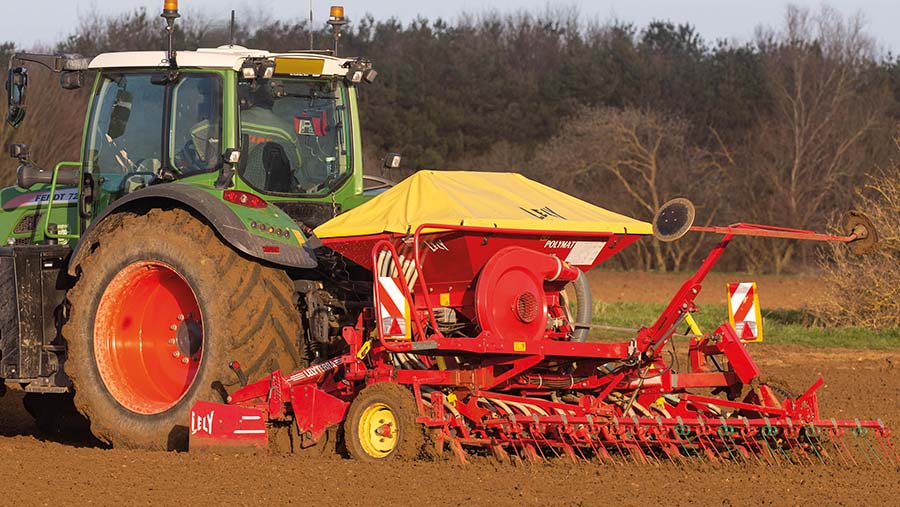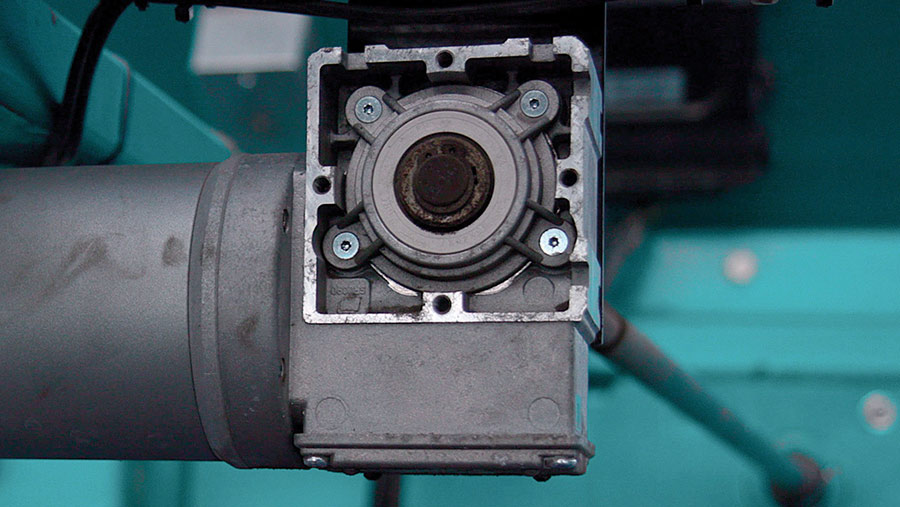How new tech turns standard drill into variable-rate system
 © Tim Scrivener
© Tim Scrivener Thanks to a new drill-conversion kit, arable farmers hoping to adopt an adjustable-rate system can now simply and affordably convert any standard drill into variable-rate capacity.
Developed by crop production specialist Hutchinsons, Omnia E-Seed is to be launched this spring and is the first standalone variable-rate drill-adaptation kit, which can fit on any standard land metered drill.
This comes at a time when many growers are hoping to cut production costs and improve the efficiency of seed and nutrition inputs, particularly with the withdrawal of the Basic Payment Scheme and the industry’s net-zero ambition by 2040.
See also: How Kent farmer has cut variable costs by focusing on soil health
The kit
The self-fit kit is available to order from late spring and includes:
- Motor and fitting plates
- Tank level sensor
- Fan speed sensor
- Auto on/off sensor
- Controllers.
The benefits
As growers look to variable-rate drilling as a means to lift crop performance, investing in a new machine that can cost more than £40,000 can be a barrier to many.
Oliver Wood, Hutchinsons precision technology manager, explains that the new technology offers an affordable way of moving to variable-rate drilling without large capital investments.

The self-fit kit can be attached to any seed drill, irrespective of age © Hutchinsons
“If there is a perfectly good drill in the shed, but it doesn’t offer variable-rate application, it can be difficult to justify the cost of replacing a good machine,” he says.
Mr Wood also acknowledges that the past two very wet autumns created challenging sowing conditions, particularly where large drills were used. Converting an older, smaller and lighter secondary drill to variable rate can, therefore, be beneficial, he adds.
Conversion costs
In a 2018 yield trial comparing a farm standard drilled winter wheat plot against a variably drilled plot using Omnia Precision Agronomy, an average increase of 0.6t/ha was found.
Based on a wheat price of £165/t, this was the equivalent of an extra £99/ha, says Nick Strelczuk, precision technology specialist for Hutchinsons.
Working on an assumption of a 0.6t/ha improvement using a variable approach, it is possible to recoup the cost of the Omnia E-Seed kit in just 48ha.
Fitting the kit
The self-fit box system can be attached to any seed drill, irrespective of age, and comprises an electric motor that bolts on and replaces the mechanical land wheel, at a cost of £4,800.
“The sensors fit virtually into the same holes as the original drill and is controlled via an app on an iPad in the tractor cab, which talks to the box,” says Mr Wood.
Variable-rate plans can be uploaded and wirelessly sent to the box, which is connected to Hutchinsons’ precision agronomy platform – known as Omnia – which operates the variable-rate control.
However, Mr Wood says the system can be used by anyone, whether they are an Omnia Precision user or not, as any variable-rate plans can be uploaded and used by the system.
Case study: Harry Horrell, Pode Hall Farm, Cambridgeshire
Working closely with growers and carrying out farm trials has been a key part of the conversion kit’s development.
Harry Horrell is one farmer involved in the process, running the Omnia E-Seed kit on his Horsch C06 drill.
“For us, being able to use the drill-conversion system means we haven’t had to change our drill and it’s a cost-effective way to bring us up to variable-rate drilling spec, which has saved us a considerable sum of money.”

Harry Horrell © Hutchinsons
Mr Horrell moved back to the family-run business more than 12 years ago and shifted away from a plough-based system to direct drilling.
About 18 months ago, the decision was made to start variable-rate seed applications, but Mr Horrell found converting his Horsch C06 drill box into a variable-rate system a real challenge. This prompted him to talk to the Omnia team and between them, a separate variable-rate unit was designed – the Omnia E-Seed kit.
“Fixing the kit to the drill was as simple as unbolting the land wheel, bolting on the box and wirelessly connecting to the iPad, which didn’t take more than a morning to do,” he says.
Variable-rate plans generated from the farm office were later uploaded to the iPad, enabling the existing standard drill to be converted.
“We’re more cost-effective, more profitable and it has allowed us to change our seed rates according to various conditions throughout the fields. We saved ourselves the best part of £100,000 for a new drill,” he says.
What’s more, Mr Horrell has noticed definite improvements in crop establishment using the approach. “The stand across fields is more even, as we have been able to battle blackgrass spots and areas of high slug pressure by increasing the seed rate in these patches.”
Case study: Jonathan Roberts, Morley Farm, Warboys, Cambridgeshire Fens
Cambridgeshire farmer Jonathan Roberts trialled the conversion kit on his farm and has been pleased with the results so far, with improved crop establishment a key benefit.
Looking to move to variable-rate drilling in a bid to improve farm profitability and promote crop development, the drill-conversion kit was an attractive option for Mr Roberts, which allowed him to convert and modernise his Moore Uni-drill.

Jonathan Roberts © Hutchinsons
“The kit was simple and easy to fit; we just fitted the motor onto the back to replace the drive unit or land wheel. The sensors virtually fitted in the same holes as the previous sensors. We then set the app up, and off we went.”
After using the system for a second season across the 140ha farm – where winter wheat, spring barley, spring wheat, potatoes and onions are grown – Mr Roberts says he does not want to go back to his standard approach.
“Walking the fields now, there is definitely an improvement in the crops. We have had a very wet winter and the crops look really good – even in some areas of our wheats that traditionally would have struggled.”
He also adds that the technology is simple and easy to run, and you don’t have to be technically minded to operate the tool.
“We can set our own rate and adapt this on the iPad – you don’t even have to have a variable-rate plan. It’s just as easy to turn off the variable-rate functionality as it is to turn it on,” he explains.
“It has given us a greater drilling flexibility and it’s a lot easier to calibrate. I can take the iPad out of the cab and calibrate the drill – there’s no more winding the handle several times and working it all out.”

